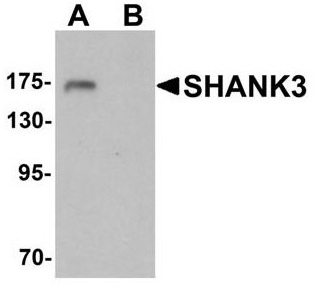SHANK3 Antibody (Center)
Rabbit Polyclonal Antibody
- SPECIFICATION
- CITATIONS
- PROTOCOLS
- BACKGROUND

Application
| WB, IHC, E |
|---|---|
| Primary Accession | Q9BYB0 |
| Reactivity | Human, Mouse |
| Host | Rabbit |
| Clonality | Polyclonal |
| Isotype | Rabbit IgG1 |
| Calculated MW | 184667 Da |
| Positive Control | Western Blot:3T3 cell Lysate IHC: Human brain tissue |
|---|---|
| Application & Usage | Western Blot: 1 µg/ml, IHC: 2.5 µg/ml, ELISA. However, the optimal conditions should be determined individually. |
| Other Names | SH3 and multiple ankyrin repeat domains 3, ProSAP2, PSAP2, SPANK-2, Proline-rich synapse-associated protein 2 |
| Target/Specificity | SHANK3 |
| Antibody Form | Liquid |
| Appearance | Colorless liquid |
| Formulation | 100 µg (1 mg/ml) in 1X PBS containing 0.02 % sodium azide. |
| Handling | The antibody solution should be gently mixed before use. |
| Reconstitution & Storage | -20 °C |
| Background Descriptions | |
| Precautions | SHANK3 Antibody (Center) is for research use only and not for use in diagnostic or therapeutic procedures. |
| Name | SHANK3 |
|---|---|
| Synonyms | KIAA1650, PROSAP2, PSAP2 |
| Function | Major scaffold postsynaptic density protein which interacts with multiple proteins and complexes to orchestrate the dendritic spine and synapse formation, maturation and maintenance. Interconnects receptors of the postsynaptic membrane including NMDA-type and metabotropic glutamate receptors via complexes with GKAP/PSD-95 and HOMER, respectively, and the actin-based cytoskeleton. Plays a role in the structural and functional organization of the dendritic spine and synaptic junction through the interaction with Arp2/3 and WAVE1 complex as well as the promotion of the F-actin clusters. By way of this control of actin dynamics, participates in the regulation of developing neurons growth cone motility and the NMDA receptor-signaling. Also modulates GRIA1 exocytosis and GRM5/MGLUR5 expression and signaling to control the AMPA and metabotropic glutamate receptor-mediated synaptic transmission and plasticity. May be required at an early stage of synapse formation and be inhibited by IGF1 to promote synapse maturation. |
| Cellular Location | Cytoplasm. Postsynaptic density. Cell projection, dendritic spine. Note=In neuronal cells, extends into the region subjacent to the postsynaptic density (PSD). |
| Tissue Location | Expressed in the cerebral cortex and the cerebellum |

Thousands of laboratories across the world have published research that depended on the performance of antibodies from Abcepta to advance their research. Check out links to articles that cite our products in major peer-reviewed journals, organized by research category.
info@abcepta.com, and receive a free "I Love Antibodies" mug.
Provided below are standard protocols that you may find useful for product applications.
Background
SH3 and multiple ankyrin repeat domains 3 (SHANK3), a member of the Shank gene family, plays a role in synapse formation and dendritic spine maturation. Shank proteins (Shank 1-3) containing PDZ domains are scaffold proteins of the postsynaptic density (PSD) that connect neurotransmitter receptors and ion channels proteins to the actin cytoskeleton and G-protein-coupled signaling pathways. Transcript splice variation in the Shank family influences the spectrum of Shank-interacting proteins in the PSDs of adult and developing brain to ensure normal development. Mutations of SHANK3 are a cause of autism spectrum disorder (ASD) and the neurological symptoms of 22q13.3 deletion syndrome.
If you have used an Abcepta product and would like to share how it has performed, please click on the "Submit Review" button and provide the requested information. Our staff will examine and post your review and contact you if needed.
If you have any additional inquiries please email technical services at tech@abcepta.com.













 Foundational characteristics of cancer include proliferation, angiogenesis, migration, evasion of apoptosis, and cellular immortality. Find key markers for these cellular processes and antibodies to detect them.
Foundational characteristics of cancer include proliferation, angiogenesis, migration, evasion of apoptosis, and cellular immortality. Find key markers for these cellular processes and antibodies to detect them. The SUMOplot™ Analysis Program predicts and scores sumoylation sites in your protein. SUMOylation is a post-translational modification involved in various cellular processes, such as nuclear-cytosolic transport, transcriptional regulation, apoptosis, protein stability, response to stress, and progression through the cell cycle.
The SUMOplot™ Analysis Program predicts and scores sumoylation sites in your protein. SUMOylation is a post-translational modification involved in various cellular processes, such as nuclear-cytosolic transport, transcriptional regulation, apoptosis, protein stability, response to stress, and progression through the cell cycle. The Autophagy Receptor Motif Plotter predicts and scores autophagy receptor binding sites in your protein. Identifying proteins connected to this pathway is critical to understanding the role of autophagy in physiological as well as pathological processes such as development, differentiation, neurodegenerative diseases, stress, infection, and cancer.
The Autophagy Receptor Motif Plotter predicts and scores autophagy receptor binding sites in your protein. Identifying proteins connected to this pathway is critical to understanding the role of autophagy in physiological as well as pathological processes such as development, differentiation, neurodegenerative diseases, stress, infection, and cancer.



